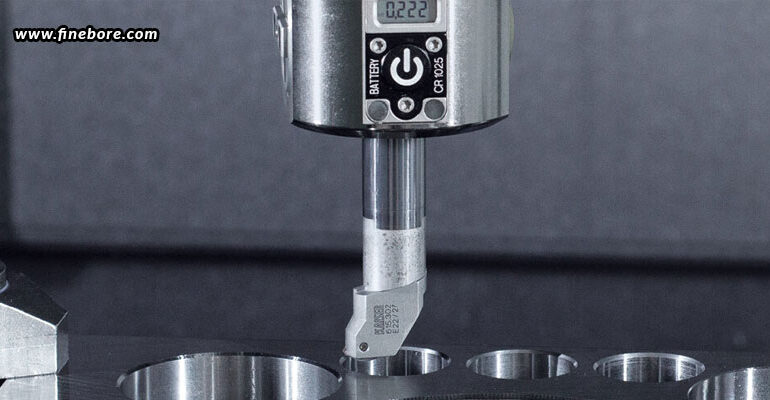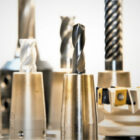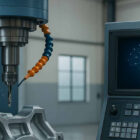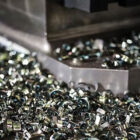In order to attain tight tolerances and expand holes to precise dimensions, boring heads are crucial equipment in precision machining. Nevertheless, machinists frequently face a variety of difficulties while utilizing boring heads, despite its significance. It’s essential to comprehend these typical problems and know how to solve them if you want to keep up productivity and guarantee excellent outcomes. We’ll go over some of the most typical issues with boring heads in the blog below, along with advice from seasoned machinists to help you make the most out of your boring operations.
Poor surface finish
When employing boring heads, one of the most frequent problems machinists face is getting a poor surface finish. Several things might lead to an uneven or rough surface: vibration during the cutting process, dull cutting instruments, and incorrect tool configuration.
Solution:
- Ensure that the spindle and boring head are positioned correctly. A poor surface quality might result from the tool cutting unevenly due to misalignment.
- Replace or sharpen your cutting tools since dull ones might leave a rough surface. To keep a clean cut, regularly check, sharpen or replace the cutting tools.
- Surface chatter marks may result from vibration. To lessen vibration, use a balanced boring head and lower the spindle speed. Furthermore, make sure the workpiece is fastened firmly to avoid movement during machining.
Excessive tool wear
Another frequent issue that can result in shorter tool life and subpar machining is excessive tool wear. Incorrect cutting settings, such as an excessive feed rate, speed, or depth of cut, are frequently the source of this problem.
Solution:
- Set the feed rate, depth of cut, and cutting speed in accordance with the material to be machined. For instance, while dealing with tougher materials, lowering the feed rate and cutting speed might assist avoid excessive wear.
- To minimize heat generation during the cutting operation, make sure the right coolant is utilized. A well-maintained tool may significantly extend its lifespan.
- Use cutting tools made from materials appropriate for the particular machining operation. For example, carbide-tipped tools are better suited for tougher materials because they are more resistant to wear than high-speed steel (HSS) tools.
Boring head runout
Runout, or the boring tool’s radial deviation, can result in concentricity and hole size errors. Runout is frequently brought on by worn-out parts, spindle problems, or incorrect tool setup.
Solution:
- Examine the tool setup to make sure the boring head is positioned correctly and in the centre of the spindle. A minor misalignment might result in a large amount of runout.
- Examine the spindle’s condition for wear or damage that could result in runout. To ensure accuracy, get the spindle repaired or replaced as needed.
- To minimize runout, routinely inspect the boring head assembly for worn or broken parts, such as bushings or bearings, and replace them as necessary.
Inconsistent hole size
A major problem in precision machining, when tight tolerances are necessary, is inconsistent hole size. A number of things, such as heat expansion, tool wear, or incorrect machine settings, might cause this issue.
Solution:
- Differences in hole size may result from the workpiece or tool’s thermal expansion. Prior to final machining, use the proper cooling methods and give the workpiece time to stabilize at room temperature.
- To maintain uniform hole sizes, periodically inspect the boring head and cutting tools for wear and replace them as needed.
- Verify that the feed rate and spindle speed are accurately adjusted for the intended work. Different hole sizes may result from incorrect settings.
Vibration and chatter
In boring operations, vibration and chatter are frequent problems that result in a subpar surface quality and a shorter tool life. A number of things, such as uneven tools, high cutting forces, or inadequate machine stiffness, can lead to these problems.
Solution:
- Significant vibration can be caused by an unbalanced boring head. To reduce imbalance, use a balanced boring head and make sure the cutting instruments are spaced equally.
- To reduce cutting forces and minimize vibration, adjust the cutting settings, such as cutting speed or depth of cut.
- To increase the rigidity of the machine, make sure that all of the parts are firmly secured and that the machine is rigid. For better stability and a lower chance of chatter, think about utilizing a shorter tool overhang.
Tool breakage
Tool breakage is a serious problem that can cause production to stop and lead to costly downtime. Excessive cutting pressures, poor tool selection, or insufficient coolant application are frequently the causes of this issue.
Solution:
- Select the right cutting tools for the particular machining task and the material. For hard materials, for instance, employing a carbide tool can lower the chance of fracture.
- To minimize heat and friction during cutting, make sure the right kind and quantity of coolant are used. The tool can avoid overheating and breaking with proper cooling.
- To lessen cutting pressures and lower the chance of tool breakage, decrease the depth of cut, feed rate, or cutting speed.
Inaccurate depth of cut
In boring operations, obtaining a precise depth of cut is essential, particularly when machining deep holes. Misalignment, worn out tools, and improper machine settings can all lead to an inaccurate depth of cut.
Solution:
- Verify the machine settings to make sure the depth of cut is adjusted appropriately. To keep an eye on the depth in real time, use the DRO (Digital Readout) system on the machine.
- To make sure the hole is the right depth after machining, use a depth gauge or micrometre to manually measure the hole’s depth.
- Examine the cutting tool for wear, as this might compromise the precision of the cut’s depth. To preserve accuracy, replace any worn-out tools.
Difficulty in chip evacuation
Maintaining a precise and clean cut requires efficient chip evacuation. Inadequate chip evacuation may result in issues with surface finish, increased heat, and clogging.
Solution:
- Use coolant to assist in removing chips from the cutting area. Moreover, coolant aids in lowering heat and friction when cutting.
- Select cutting tools featuring suitable chip breakers or flute designs that facilitate effective chip evacuation.
- To forcefully evacuate chips from the cutting area during deep hole boring, think about using a high-pressure coolant system.
Tool slippage
Tool slippage, which can result in errors and possible workpiece damage, happens when the boring tool moves within the boring head during machining.
Solution:
- Ensure that the right clamping mechanism is being used to firmly secure the boring tool in the boring head. Verify that all bolts and screws are securely fastened.
- To improve grip and stop slippage, think about applying anti-slip coatings or adhesives to the tool shank.
- To keep a firm hold on the tool, periodically check the clamping mechanism for wear or damage, and replace any worn parts.
Misalignment between spindle and workpiece
Inaccurate surface finish, off-centre holes, and tool wear can all be caused by misalignment between the spindle and the workpiece. Worn-out machine parts or incorrect machine configuration are the main causes of this issue.
Solution:
- Before beginning the boring process, make sure the spindle and workpiece are precisely aligned using dial indications or laser alignment tools.
- Look for wear or damage on the spindle bearings and gibs, among other machine components. To preserve alignment, replace any worn components.
- To accurately place the boring head in relation to the workpiece, think about utilizing a centring device.
A thorough grasp of the machining process and meticulous attention to detail are necessary for troubleshooting boring head difficulties. You may overcome typical obstacles and optimize your boring operations for improved accuracy, surface smoothness, and tool life by paying attention to the solutions and guidance offered by professionals in the field. To prevent these problems and guarantee constant, excellent outcomes in your machining tasks, it is essential to practice routine maintenance, appropriate tool selection, and cautious machine setup. FineTech Toolings is one of the best precision boring head manufacturers in Bangalore for customers looking for dependable and superior precision boring heads. Dedicated to quality and cutting-edge technology, FineTech Toolings provides precision tools that satisfy the demanding requirements of contemporary machining, guaranteeing outstanding performance and durability.






